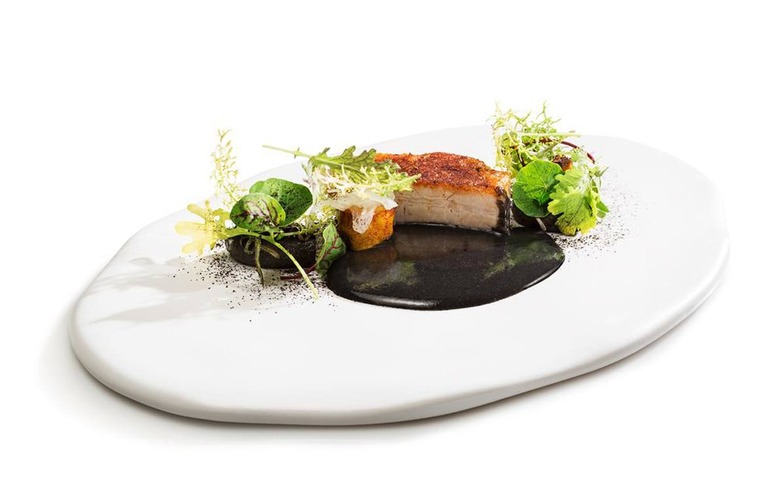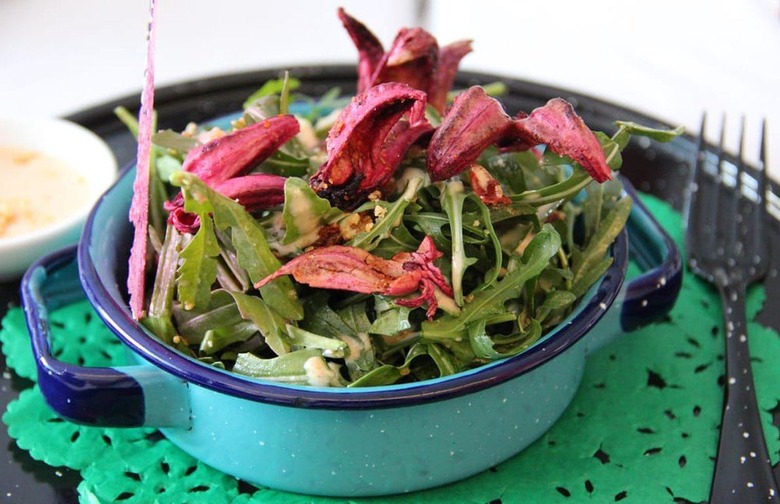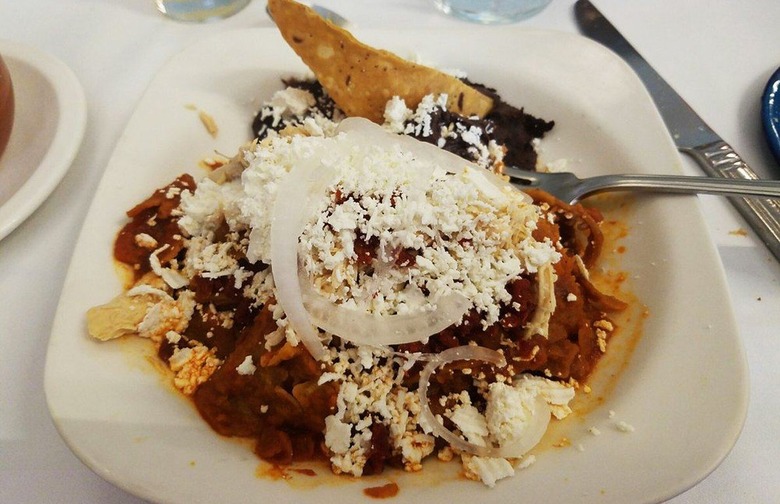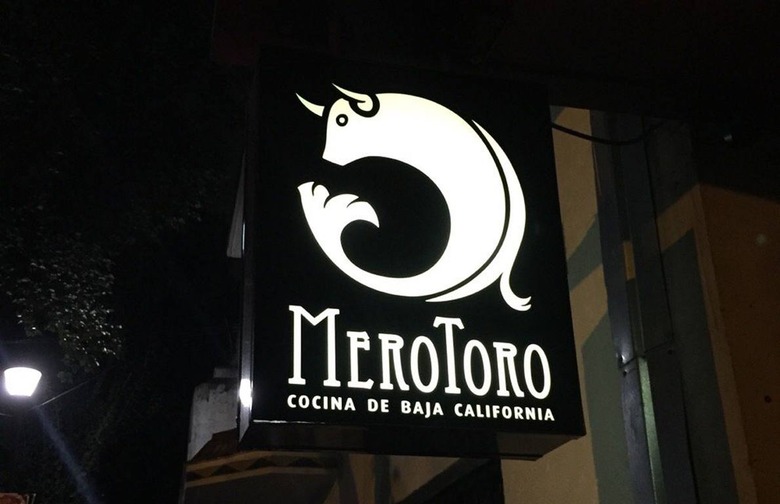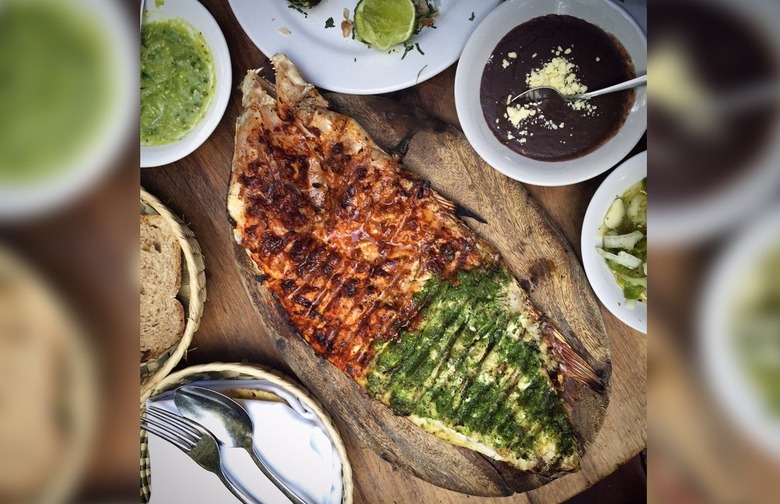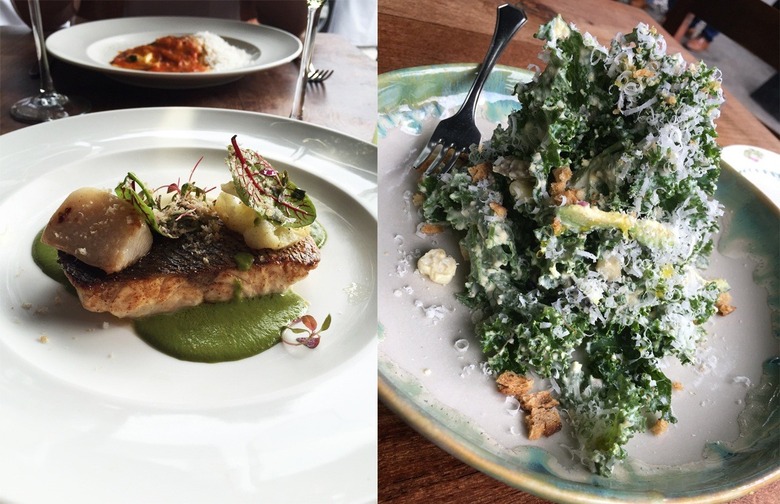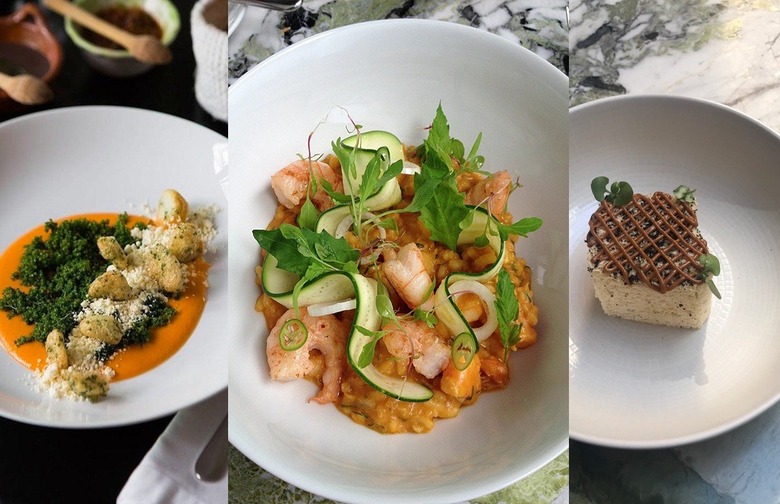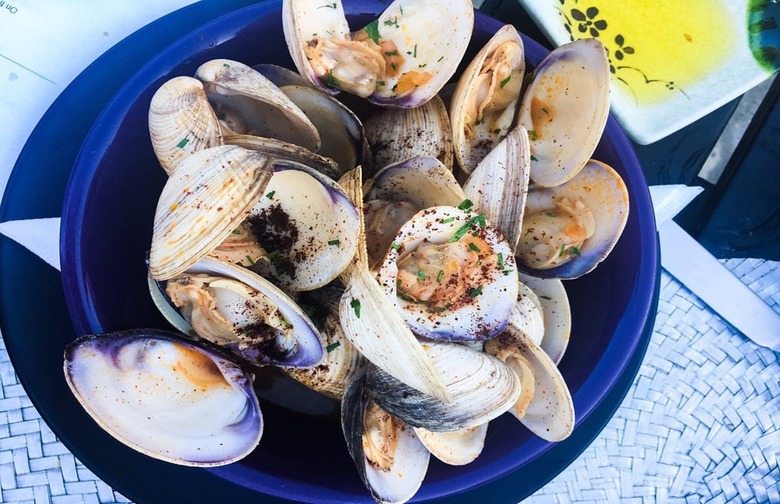Slideshow: The 18 Best Restaurants In Mexico
Miguel Ángel Guerrero Yaguës, the chef-proprietor of this Tijuana original, may have coined the term "Baja Med" — and he was certainly one of the earliest practitioners of this tantalizing hybrid cuisine. La Querencia has a hip, contemporary-industrial look: bare concrete floors, lacquered steel tables, and exposed ducts overhead. Subtle, low-tech touches abound, like mounted game trophies on the walls, a tropical fish tank at one end of the dining room, and a row of rusty cooking implements hanging above the divider that separates the open, stainless-steel kitchen from the dining room. The focus here is on fresh Baja seafood — scallop carpaccio, grilled shrimp salad, salmon tarta, a mixed seafood plate with red and white miso sauces and hot chiles. Also available are dishes like fresh pasta with several sauces to choose from, lamb chop in pesto sauce, and a range of tacos, tostadas, and burritos employing such uncommon fillings as smoked marlin, giant squid, manta ray, tuna fin stew, and abalone "chorizo" — all of it delicious.
#17 Flora’s Field Kitchen (San José del Cabo, Mexico)
Its location down a rutted dirt road may make some tourists wary, but don't let the adventure of getting there deter you. Flora's Field Kitchen, located on Flora Farm, a 10-acre organic farm-plus-market in the foothills of the Sierra de la Laguna Mountains, offers an unforgettable farm-to-table dining experience in a beautiful setting. All ingredients used come from the farm, owned by Gloria and Patrick Greene; breads are made in a wood oven, and the free-range meat comes from their nearby 150-acre ranch. Chef Aaron Abramson, a veteran of Blue Hill at Stone Barns, offers diners everything from a sandwich of homemade sausage with pickled vegetables (at lunch), to burrata with tapenade, to 12-inch pizzas from the wood oven. Diners rave about the fresh juices and the specialty cocktails, like the hibiscus martini or the pelo de perro ("hair of the dog"), Flora Farm's twist on the Bloody Mary. Sometimes, farm walks are offered pre-meal, and often there is live music into the early evening. A suggestion to keep in your back pocket: Diners suggest taking a cooler along so you can buy some fresh produce and artisanal goods to bring back to your hotel with you.
#16 Le Chique (Riviera Maya, Mexico)
Don't let the bare floors, bare tables, and beach-town locale (it's part of the Azul Sensatori resort) fool you: This acclaimed restaurant serves very sophisticated modernist cooking drawn from Mexican tradition (and using local ingredients) but informed by the culinary styles of places like Noma, elBulli, and El Celler de Can Roca — in all of whose kitchens head chef Jonatán Gómez Luna Torres has worked. Expect unusual presentations, uncommon textures, and trompe l'oeil constructions — like a perfect lemon that's actually a candy shell filled with lemon curd. Menus are written in the elliptical style so à la mode these days: cherry + Campari, corn + mole prieto, aguachile + prawns + dragonfruit, smoked plantain + chocolate. Come without preconceptions and leave amazed.
#15 Casa Oaxaca (Oaxaca, Mexico)
A consistent favorite in this vibrant regional capital, with a charming courtyard and an atrium dining room, Casa Oaxaca serves an ample menu of local specialties, including maguey worm tostadas with chicatana ant mayonnaise; tlayudas (the so-called "Mexican pizzas") with chorizo or thin-sliced beef; and a whole repertoire of moles, the specialty of Oaxaca, including some made with rabbit and beef tongue. There's a good list of bottles from the major Mexican wine regions, and of course an arsenal of mezcals.
#14 Dulce Patria (Mexico City)
Presentation is important at Martha Ortiz's popular, idiosyncratic, colorful restaurant, whose look is said to have been inspired by the works of famed artist Frida Kahlo (Ortiz's mother, Martha Chapa, is a famous artist too): The food comes presented in small birdcages, on wooden airplanes, on a miniature carousel, and sometimes just in or on unusual custom-made plates or bowls. And what food it is! From her mole bread (and acclaimed pink mole) to her multi-hued empanada-like quesadillas, foie gras and black bean soup, and crispy salmon with corn sauce, this is inspired, highly original cooking. And be sure to order a tequila shot, served with side shots of sangrita, beet juice, and tomatillo juice — a whole new way of drinking.
#13 Nicos (Mexico City)
Mexico City is becoming one of the world's great food cities, full of must-visit, handsomely designed establishments from Enrique Olvera's spectacular Pujol on down, but one of the best places of all is this modest storefront in an out-of-the-way neighborhood, founded in the 1940s by the mother of the current chef-proprietor, Gerardo Vázquez Lugo. The stylistic (and culinary) equivalent of that perfect little bistro you always hope to find in some far-flung arrondissement of Paris, Nicos serves perfectly realized versions of a wide range of traditional dishes — impeccable tableside guacamole and Caesar salad, enchiladas in green sauce, smoked duck salpicón, organic pork in Guadalajara-style adobo with dried chiles and chocolate, and flan with cajeta (caramelized goat's milk).
#12 Deckman's at El Mogor (Valle de Guadalupe, Mexico)
Georgia-born chef Drew Deckman — who won a Michelin star at Restaurant Vitus in the northern German town of Reinstorf, was executive chef at the Raffles L'Ermitage Hotel in Beverly Hills, and may or may not have cooked privately for Tom Cruise — became famous in Baja California for his San José restaurant in Los Cabos. For several years, he'd leave the place in summertime and migrate north to Baja's Valle de Guadalupe, Mexico's premium wine country, to cook at an informal outdoor restaurant there at the Mogor Badán winery. Now he has moved permanently north, taking up fulltime residence at Mogor Badán, which is also an organic farm — a fact Deckman takes full advantage of. Even the olive oil comes from the property (and the seafood from the nearby Baja coast). Dinner is served at picnic tables outside with a view of the vines, or under a tin roof, and the cooking is all done with live fire (no gas or electric ranges). Expect Baja Kumiai oysters, grilled local fish, grilled octopus, grilled quail, roast pork, and other straightforward but perfectly prepared specialties that enhance, and are enhanced by, the local vintages.
#11 MeroToro (Mexico City)
"Mero" is grouper; "toro" is bull. Put them together and you have a splendid surf-and-turf-themed restaurant opened in 2010 by Gabriela Cámara and Pablo Bueno of the popular Contramar. The place may be located in Mexico City's posh Colonia Condesa, but the vibe is relaxed (bare tables and slat-backed chairs, open kitchen) and the inspiration comes from far to the northwest, from Baja California. Cámara and Bueno have secured the services here of one of that region's most accomplished chefs, Jair Téllez of Laja in the Valle de Guadalupe, Baja wine country. Téllez pleasantly surprises palates in the Mexican capital with fresh ceviches, risotto with bone marrow and red wine, birria (a spicy stew usually made with mutton or goat) of clams, and a delicately cooked grouper (of course) on a bed of puréed cauliflower. Tellez's signature dish, though, shows that he has both feet on the ground: pan-fried pork jowl with lentils and a poached egg. Plus, the excellent sourdough bread is unique in Mexico.
#10 Finca Altozano (Valle de Guadalupe, Mexico)
Javier Plascencia is the restaurant king of Tijuana, the once-sordid border town that has become an important dining destination for food-lovers in Baja and Alta California alike (see Misión 19, No. 2) — but this sprawling, open-sided restaurant on a dirt road in the middle of Baja wine country is in a class of its own. Here, Mexican and Mediterranean products and preparations mix comfortably — the region produces excellent olive oil as well as wine, and of course all the Mediterranean vegetables grow well here. The mountain ham with tomato bread is as good as what you'd get in Spain, and the fresh local vegetable risotto would do an Italian proud. There's a selection of Baja oysters, too. But then Plascencia offers miniature tostadas of octopus ceviche, tacos filled with everything from refried beans to beef tongue, roasted local baby lamb with just-made tortillas on the side, and duck confit in black mole with charred dates. Talk about the best of two worlds.
#9 Moxi (San Miguel de Allende, Mexico)
Condé Nast Traveler anointed San Miguel de Allende, a pleasant and colorful artists' and American retirees' community in the state of Guanajuato (northwest of Mexico City), as the top city in the world several years ago — leaving such burgs as Barcelona, Paris, and Sydney in the dust. San Miguel is certainly an engaging and eye-catching place, and one of its great attractions — and a rare example of contemporary architecture in the city — is the Hotel Matilda, a comfortable and alluring hostelry graced by an excellent restaurant, Moxi. Moxi is under the direction of Enrique Olvera, of Mexico City's unparalleled Pujol and the hot Manhattan entry Cosme. Here, in a pleasant, art-enhanced dining room with a breezy terrace, Olvera's crew draws heavily on organically-raised local produce to create Mexican-accented international cuisine: shrimp burgers with tartar sauce and guacamole; eggplant mole with artichokes and cherry tomatoes; wild mushroom risotto with guajillo chile and red onion; confit suckling pig with radishes, watercress, and beans puree; and many other vividly flavored delights.
#8 Contramar (Mexico City)
Gabriela Cámara, the chef–proprietor of this perpetually crowded seafood restaurant, has recently opened the innovative Cala in San Francisco, but she is hardly neglecting her original establishment. This is one of those places that visiting chefs always want to go to, and you can see why. The food here is based on the freshest possible ingredients (yes, Mexico City is inland, but there is a tremendous demand for top-quality seafood here, and purveyors manage to get fish and shellfish into local kitchens mere hours after it's been caught or harvested), and the presentations are simple but right. Carnitas at Contramar are made from fish, not pork, but they're superb. Fresh tuna is filleted and grilled with a glaze of chiles; tostadas are topped with tuna or with shrimp, octopus, or crabmeat; six or eight varieties of simply cooked fish are usually offered — and the occasionally offered chiles en nogada, filled with seafood instead of pork, are not to be missed.
#7 Máximo Bistrot (Mexico City)
This first-rate restaurant made headlines in 2013 when the privileged daughter of the head of Mexico's consumer protection agency couldn't get a table and asked her father to close the place down. A storm of mocking Twitter protests forced the official to apologize and the place remained open. Máximo's chef-owner, Eduardo García, was in the news again this year when he penned an editorial for The New York Times about how he had been an undocumented migrant worker in America and was jailed and later deported — which ultimately gave him the chance to open his "bistrot." Diners are glad that he did, because García's solid French-Mexican cooking is some of the best in the capital. Consider octopus ceviche, beef tartare, roasted bone marrow, sea bass with green mole, roast organic chicken with foie gras risotto...
#6 Corazón de Tierra (Valle de Guadalupe, Mexico)
Sitting in this rustic-modern dining room in the middle of Mexico's Baja California wine country, you can look outside and see the kitchen garden from which chef Diego Hernandez culls some of his herbs and vegetables, and the orchard that yields fruit for his tables. What you can't see, because it's 15 miles or so away, is the Pacific Ocean from which the chef obtains the super-fresh seafood, from oysters to octopus to rock cod or tuna, that forms a large part of his ever-changing menus. Add in homemade breads and occasional specials like roast quail with black beans and honey–yogurt ice cream with banana purée and chocolate crispbread and irrigate everything with choices from the on-site Vena Cava Winery, and you have an extraordinary wine country experience.
#5 Biko (Mexico City)
The Mexican-Spanish fusion cuisine served at Biko — which consistently ranks at or near the top of numerous lists of the world's best restaurants — is described by chefs Bruno Oteiza and Mikel Alonso as "sumptuous with surprises." The menu, which changes often, focuses on locally sourced seasonal ingredients, turned into refined, simple dishes that match the minimalist décor of Biko's dining room. Current choices include quail with truffles, seaweed, and olives; daily fish confit with chiles, pistachios, and mushrooms; piquillo peppers stuffed with aged wagyu beef; and brownie mousse with coconut sponge.
#4 Quintonil (Mexico City)
One of the bright stars of modern Mexican cuisine, Jorge Vallejo — a veteran of Pujol (see No. 1) and onetime stagiaire at Noma — opened this good-looking Polanco restaurant in 2012 in partnership with his wife, Alejandra Flores, former director of operations for Pujol's Enrique Olvera. The restaurant quickly became a Mexico City essential, thanks to such savvy, savory preparations as cactus ceviche with beets and mandarin orange, grilled trout and roasted huitlacoche with spicy potato sauce and smoked trout roe, turkey in black annatto and cacao husk sauce with fermented vegetables and confit onions, and Ocosingo cheese flan with celeriac ice cream and sugar-coated cacao nibs.
#3 Manzanilla (Ensenada, Mexico)
Manzanilla is a place with personality. Husband-and-wife chefs Benito Molina and Solange Muris, pioneers of the so-called "Baja Med" movement, opened this Ensenada hotspot in a smaller locaion in 2000, tapping into the Baja California region's natural ingredients and resources. "[Baja California] has the best fish, the best alcohol, the best wine, so the combination is just perfect. It's every chef's dream to live [here]," Molina said once in an interview. Now in a new location just outside the port of Ensenada, the cooking is better than ever. The menu at Manzanilla is heavily seafood-focused, offering such delights as truly memorable fish with ginger, chile serrano, and soy sauce; oysters smoked with tarragon butter; fish of the day with black bean purée and the tropical leaf called cat's claw; and for the non-piscatorially inclined, open quail meat ravioli, rice with oxtail and huitlacoche, Baja ribeye with salt-baked potatoes and baby vegetables, and a few other meaty specialties. Be sure to investigate the wine list, heavy with choices from the nearby Valle de Guadalupe.
#2 Misión 19 (Tijuana)
Javier Plascencia, whose family owns everything from pizzerias to the revivified dining room at Hotel Caesar's (whose original proprietor, Cesare Cardini, invented the Caesar salad), has been instrumental in helping to turn the infamous border town of Tijuana into an increasingly serious restaurant town. Looking out on the city from the second floor of a modern office building, Misión 19 — with wraparound windows, an open latticework of wood enclosing the bar, pastel neon accents, and cactuses that look like something out of a cartoon — is Plascencia's flagship, his most innovative and original restaurant. Among the dishes with which Misión 19 tempts diners are a baby kale, avocado, and compressed cucumber salad with cured salmon, trout, and goat cheese dressing; risotto with heirloom beans, wild mushrooms, and huitlacoche; seared fresh local tuna with cactus, black mole caramel, and pickled shimeji mushrooms; and tablitas (crosscut beef ribs) vacuum-cooked for 48 hours and served with "cracklings" of beluga lentils, chayote, and Brussels sprouts.
#1 Pujol (Mexico City)
After graduating from the Culinary Institute of America in Hyde Park, New York, and working for the superb Alsatian-born chef Jean Joho at Everest in Chicago, Enrique Olvera opened this contemporary-style restaurant in Mexico City in 2000 with the idea of using indigenous ingredients and traditional cooking methods to produce Mexican haute cuisine. He succeeds admirably with such dishes as pork chicharrón and purslane (a succulent) in salsa verde, and the remarkable "mother mole," cooked for hundreds of days and containing scores of ingredients, served as a pool of sauce with translucent sesame tortillas. The original restaurant had black walls and was minimalist in décor, as much for economic reasons when Olvera was starting out as by stylistic choice, but in February of this year, he closed the place down and opened an elegant upgrade not far away, with natural materials, neutral shades, plenty of natural light, and an organic garden just outside. The restaurant's list of mezcals remains eye- and palate-opening (try the Farolito, made from wild agave, fermented in leather, and distilled in clay), and the collection of Mexican wines, especially the reds, is one of the country's most extensive.

